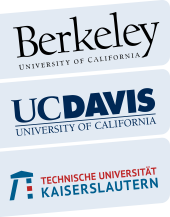

RESEARCH PROGRAM
Title: Application of Efficient Discrete Particle Methods in Modeling Metal Binder Jet Sintering
Name: Roger Isied
E-Mail: ruisied@berkeley.edu
Phone: 1-510-424-2232
Project description:
Starting situation
Binder Jetting is a variation of selective laser sintering (SLS) that provides a means of additively manufacturing dense metallic components without the use of a laser to sinter/melt together part geometries. This process is unique in that a 3D part layer is created fully with a single pass of a print head, allowing for many parts to be created on a single print bed in less time than SLS. This process is geared toward production scale runs of additively created metallic components.
Approach
Within the binder jetting process, there are several indicators that can fully evaluate components created using this method. These include (1) particle density before and after sintering, (2) uniformity of binder within the powder, (3) part shrinkage due to thermal gradients when sintered, (4) thermal stresses that arise from sintering, and (5) internal defects that can originate from nonuniform powder bed spreading. These characterizations can be controlled by manipulating process parameters such as (1) metal powder particle size, (2) print layer height, (3) metal powder/binder jet resolution, (4) lamp heating temperature, (5) lamp heating rate, (6) sintering rate, and (7) binder polymer concentration. The ultimate goal of the study is the creation of a process-independent model that is based solely on basic physical principals to objectively evaluate the efficacies of these processes.
Expected Results
I propose to separate the binder jetting process into individual steps and utilize different particle-based methods which best align for the output goals of the simulation. For particle deposition, I plan to use the Discrete Element method to quickly and qualitatively model particle deposition through basic equations of motion. I then look to use the Material Point Method for simulation of binder heating and evaporation. Finally, I will use the Particle Finite Element method to observe how the use of support structures can mitigate sagging of parts while in the sintering oven. All of these methods are to be coded from scratch using a combination of Fortran and Python, depending on what capabilities are required for each simulation method.

Figure: Deposition of metal powder onto print bed modelled using the Discrete
Element Method. Particle starting positions (Left). Particles colliding with print bed (Right).

